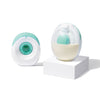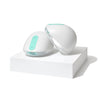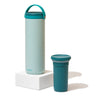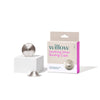Mama, do all your shirts carry the hallmark formula or breast milk spit-up signature? We’ve all been there. And we also know that regardless if this happens to your baby once or several times a day, it can be a bit alarming. But, is baby reflux a cause for concern?
Rest assured, baby reflux is rarely serious. So long as you understand what to keep an eye out for, your baby will more than likely grow out of it. Let’s dive into some of the details and what you can do to help your little one.
What Is Baby Reflux?
In the most simple terms, baby reflux or infant reflux is when your baby spits up. And according to the Mayo Clinic, this is due to food moving back up into your baby’s esophagus from the stomach. If the muscle (LES) between the esophagus and stomach relaxes while the stomach is full, food might flow back up.
According to Healthline, babies are more prone to acid reflux because the LES muscle is often weak or underdeveloped at that stage in life. Plus, babies spend a lot of time sleeping and lying down and they eat more liquid meals than adults do.
This is also sometimes called gastroesophageal reflux (GER). The good news is that the condition is rarely serious. Plus, it becomes less common as your baby grows. According to the Mayo Clinic, it’s unusual for baby reflux to continue after 18 months.
Common Baby Acid Reflux Symptoms
The most obvious symptom is spitting up. Your baby might start to dribble a bit or may even spit up what looks like their entire meal. While spit-up is normal, it’s important to keep an eye out for symptoms that may point to an underlying health condition called gastroesophageal reflux disease (GERD) or another medical condition.
Baby Acid Reflux Symptoms to Watch Out For
According to the National Institute of Diabetes and Digestive and Kidney Diseases, symptoms of GERD in babies include:
-
Arching of the back and abnormal movements of the chin and neck
-
Choking, gagging or issues with swallowing
-
Irritability after spitting up
-
Loss of appetite or refusing to take a bottle or breast
-
Poor weight gain, cough or wheezing
-
Vomiting
The NIDDK also states that other medical conditions can have similar symptoms of GERD. Some of the symptoms that point to another medical issue include:
-
Crying more than usual
-
Failure to thrive (weighing less than expected for a baby’s age)
-
Breathing issues
-
Swallowing issues
-
Vomit that contains blood or looks like coffee grounds
-
Rectal bleeding
-
Signs of dehydration such as no wet diapers for 3 hours or more
-
Vomiting that is forceful and in large amounts
Some of the potential medical conditions include food intolerance or allergy, pyloric stenosis or a condition that blocks food from flowing into the small intestine and esophagitis or inflammation of the esophagus.
How to Help Baby With Reflux
If your baby is experiencing common baby reflux, there are several ways you can help. But first, you should always speak to your baby’s doctor.
1. Speak to Your Doctor About Underlying Issues
The medical conditions listed above have the potential to be serious. If you’re concerned about your baby’s symptoms and if normal spit-up just doesn’t seem to fit what’s happening to your baby, please reach out to your doctor.
Your doctor will be able to run the necessary tests to check for food allergies and underlying conditions. And if your baby is simply experiencing normal reflux, they can give you some additional tips and tricks to help.
2. Breastfeeding & Baby Reflux
While some babies may simply spit up to an underdeveloped LES, others just eat too much too quickly. This is common in breastfeeding, especially with forceful eaters. It’s also common due to breasts being overfull or due to forceful letdown.
Babies who are easily distracted while at the breast or bottle may also swallow air that can lead to reflux. If you breastfeed, here are some ways you can help reduce reflux:
-
Switch to more frequent feedings: Smaller amounts of milk are often easier to digest which can help with reflux. To ensure your milk supply doesn’t decrease, you’ll need to breastfeed more often this way.
-
Try a new feeding position: Try a more upright breastfeeding position as described below. If bottle feeding, reduce the intake of air by using an upright feeding position with your baby’s head tipped slightly forward.
-
Find a quiet place to nurse to ease distraction: Babies that aren’t distracted might nurse better and avoid taking in excess air in a quiet and dark place.
-
Hand express before feeding: If your letdown is strong, try hand expressing a small amount of milk before bringing your baby to the breast.
3. Upright Feeding Positions
While breastfeeding try aposition that keeps your baby’s head higher than their belly is a great place to start.
For example, you can try the koala hold by holding your baby in a vertical position while they’re at your breast. Or, try the football hold. In this position, you’ll hold your baby like a football with their bottom lower than their head.
It’s important to keep your baby upright after feeding too. To help with reflux, you’ll want to keep your baby in an upright position for 20 to 30 minutes after a feed to allow milk to flow properly. Save the tummy time for later, mama.
4. Burp Regularly
It’s recommended that you burp your baby 2-3 times during each feeding. This helps reduce the amount of air your baby takes in, which can reduce reflux.
5. Purchase Baby Dribble Bibs
This is more for you, mom, than it is for your baby. You already do so much laundry. Dribble bibs can save that cute onesie from another spit-up explosion. There are many types available, from bandana style to bibs that double as teethers. When the inevitable spit-up does happen, you’ll be prepared.
6. Reduce Feeding Time
As we mentioned before, shortening your baby’s feeding time can help reduce reflux as it enables easier digestion. For example, try feeding every 2-3 hours instead of every 3-4.
It’s important to remember that every baby is unique. This type of feeding schedule may not float your baby’s boat and that’s okay. Try it and if it doesn’t work, go back to your normal feeding schedule. Baby eating is what’s most important.
7. Diet Changes
Some studies report that up to 40 percent of infants with problematic GER have a food protein intolerance, most commonly cow’s milk and soy protein. If you’re breastfeeding your baby, you can try eliminatinating all cow's milk proteins and beef from your diet. After two weeks you should see an improvement if this is the contributing to your baby’s symptoms.
Additionally, avoid exposing the infant to tobacco smoke as it is known to lower LES tone and increase GER.
8. Avoid Tight Clothing
Tight diapers, onesies or other pieces of clothing can put pressure on your baby’s belly. This can be especially irritating if your baby is experiencing reflux. So, keep your baby in loose clothing to prevent this.
Does Gripe Water Help With Reflux?
Gripe water is an over the counter product sold in many countries to relieve colic.Yet, there’s no evidence that it works and some forms of gripe water include ingredients that may result in negative effects. For example, gripe water that contains peppermint could worsen reflux symptoms.
Speak to your baby’s pediatrician if you are interest in using natural remedies for reflux. You will want to make sure you are choosing both safe and proven remedies.
Caring for a baby with reflux can be a challenge, but you’ve got this. To learn more about breastfeeding or other tips and tricks, check out our blog.
Medically Reviewed by: Dr. Michele Torosis, M.D.
Dr. Michele Torosis is a Stanford University-trained Obstetrician and Gynecologist. She is currently completing her fellowship in Female Pelvic Medicine and Reconstructive Surgery at UCLA, where she is receiving advanced training on pelvic floor disorders. She has a special interest in postpartum pelvic floor dysfunction including obstetric-related trauma. Dr. Torosis attended the University of California, Irvine for medical school and Duke University for her undergraduate education, graduating with a Bachelor of Science in Biomedical Engineering.
Prior to completing medical school, Dr. Torosis was involved in the early stages of Willow's product development. She worked one on one with new moms for Willow's first-in-woman clinical trial and assisted with early device prototyping. Through her practice, she has remained passionate about improving the breastfeeding experience for all women.

















